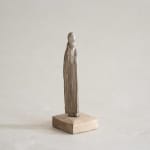



Sho Kishino (1972-Present)
Training Monk, 2019
3 1/2'' h x 1 1/4'' l x 1 1/4'' w
Sold
Further images
Sho Kishino is a sculptor based from the Nara prefecture (adjacent to Kyoto). His work is elegant and intimately scaled, yet it possesses a formidable inner presence. It is generally...
Sho Kishino is a sculptor based from the Nara prefecture (adjacent to Kyoto). His work is elegant and intimately scaled, yet it possesses a formidable inner presence. It is generally comprised of carved figures made of aged timbers collected with permission from Japanese temples.
Through a great capacity for feeling and detail, Kishino calls the spirit of this wood to life. Although he is not a practicing Buddhist, Kishino is fascinated by the aesthetics of Buddhist forms as well as the sculptures of Swiss artist Alberto Giacometti. Somewhere between the two, he arrives at the process of his own work, carving away at his wooden forms until they bear an emptiness that “presents the true essence of existence."
While his work is intensely spiritual, it is not “religious” or “Buddhist”. Kishino does not merely follow the longstanding practice of carving Buddhas in Japan; he invokes a new register of feeling and form through his own, personally driven practice as an artist. Only through the subtle chipping away of his reductive method may Kishino access the beautiful and mournful emptiness that pervades in the statue of the training monk.
Through a great capacity for feeling and detail, Kishino calls the spirit of this wood to life. Although he is not a practicing Buddhist, Kishino is fascinated by the aesthetics of Buddhist forms as well as the sculptures of Swiss artist Alberto Giacometti. Somewhere between the two, he arrives at the process of his own work, carving away at his wooden forms until they bear an emptiness that “presents the true essence of existence."
While his work is intensely spiritual, it is not “religious” or “Buddhist”. Kishino does not merely follow the longstanding practice of carving Buddhas in Japan; he invokes a new register of feeling and form through his own, personally driven practice as an artist. Only through the subtle chipping away of his reductive method may Kishino access the beautiful and mournful emptiness that pervades in the statue of the training monk.
Provenance
Directly from the artist to Mitsui Fine ArtsSignup for our Newsletter
You will receive two emails a month from us. One introduces artworks and design works from Kyoto's hidden sources and the other is stories from Misako, sharing insights into Japanese culture.
* denotes required fields
为了回应您的查询,我们将根据我们的隐私政策处理您提供的个人数据。



